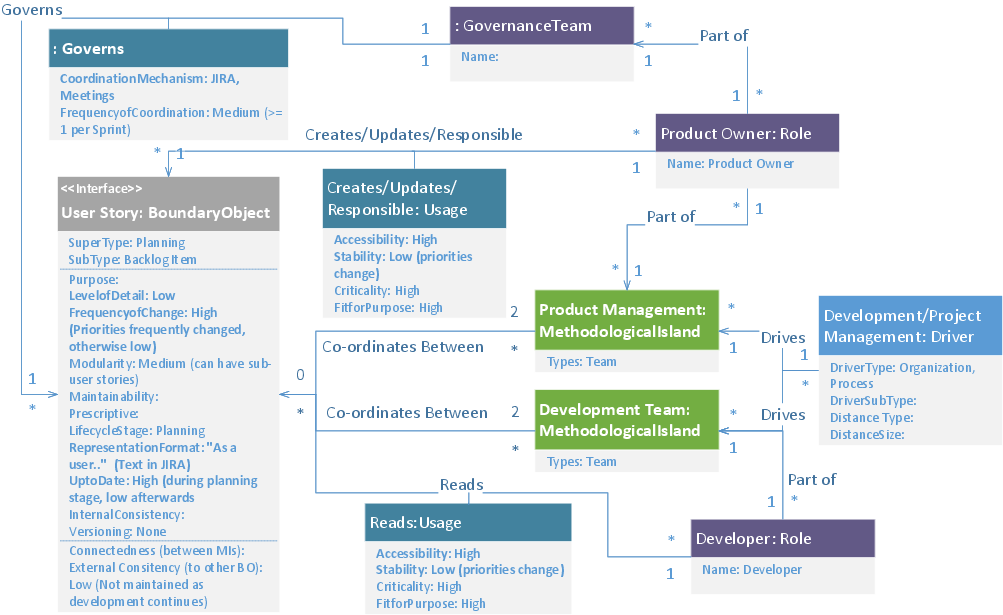- The paper presents the BOMI metamodel that structures and analyzes coordination through boundary objects and methodological islands.
- It employs UML diagrams to capture inter-team interactions and identify dysfunctional patterns similar to code smells.
- Evaluation across four companies confirms its practical utility in enhancing governance and agile development processes.
Modeling and Analysis of Boundary Objects and Methodological Islands in Large-Scale Systems Development
Introduction
The paper presented in "Modeling and Analysis of Boundary Objects and Methodological Islands in Large-Scale Systems Development" addresses the complexity of coordination within large-scale systems engineering companies, particularly in agile development environments. The paper proposes a metamodel aimed at improving the capture and analysis of coordination and knowledge management among organizational groups using diverse development methodologies, dubbed Methodological Islands (MIs). The metamodel focuses on helping practitioners identify and analyze Boundary Objects (BOs) which facilitate inter-team coordination and knowledge management.
Background
Boundary Objects and Coordination Needs:
Boundary Objects are artifacts that permit different teams to work collaboratively by providing a shared understanding while being adaptable to particular uses within different groups. In large-scale agile developments, disparate development methods lead to the formation of MIs, characterized as organizational groupings using varying methodologies. The paper builds upon previous work characterizing these coordination needs by systematically capturing MIs and BOs through a newly developed metamodel.
Methodological Islands:
MIs describe organizational groupings with developmental methodologies that differ from their immediate organizational context. Such islands can arise across teams, departments, or entire organizations due to various drivers related to business, process, and technology. Understanding the interplay between MIs and BOs is critical for optimizing inter-team coordination in complex environments.
The paper introduces the BOMI (Boundary Objects and Methodological Islands) metamodel, which uses UML class diagrams to depict the relationships and attributes of BOs and MIs. This model facilitates the systematic capture of the coordination landscape in large-scale organizations, thereby enabling a structured analysis of issues and improvement opportunities.
- Boundary Objects (BOs): Central to the model, BOs are interfaces that connect different MIs. They are characterized by attributes such as SuperType, SubType, Level of Detail, Frequency of Change, among others.
- Methodological Islands (MIs): These are groupings characterized by their methodology and contain Roles that interact with BOs.
- Drivers: Factors prompting the existence of MIs, potentially influencing inter-team dynamics.
- Governance: The model captures governance structures that manage BOs, aiding in the facilitation of consistent and aligned coordination practices.
(Figure 1)
Figure 1: Instance model of BOMI setup for User Stories for Company A.
BOMI Method and Analysis
The BOMI method involves a structured approach to creating instance models within organizations, based on guiding questions related to the metamodel. An example from Company A illustrates user stories in coordination between development teams and product management, highlighting governance and usage relationships.
BOMI Analysis:
The researchers propose an analysis of BOMI instance models using "smells" to identify dysfunctional coordination patterns, akin to code smells in software engineering. These include issues like critical BOs with low stability or governance teams not using the BOs they oversee. The systematic identification of such smells can guide further investigation and refinement of coordination practices.
Evaluation and Findings
The evaluation conducted across four large-scale companies demonstrated the practical application of the BOMI model in real industrial contexts. Feedback from workshops suggests the model's utility in identifying potential coordination issues and facilitating discussions on coordination improvements. Adjustments to the metamodel types and attributes were made based on participant feedback, enhancing the model’s applicability.
The paper places the BOMI approach within the context of related work in knowledge management, agent-oriented modeling, communication, and coordination. Notably, the BOMI metamodel adapts and expands on existing concepts to focus sharply on inter-team coordination within large-scale systems development.
Discussion and Future Work
The BOMI model has been shown to effectively facilitate the understanding of complex coordination environments in large-scale systems development. Future research directions include refinement of BOMI-specific smells, exploration of domain-specific visual languages for better user engagement, and development of constructive methods to aid organizations in proactive coordination improvements.
Conclusion
The paper provides a rigorous, empirically grounded framework for modeling boundary objects and methodological islands in large-scale systems development, offering a tool for practitioners to systematically capture and analyze complex coordination scenarios. This work lays a foundation for ongoing improvements in coordination practices, with implications for broader methodological integration.

Figure 3: BOMI model applied to a User Stories use case in Company A, showing the interaction of Development and Product Management teams.
